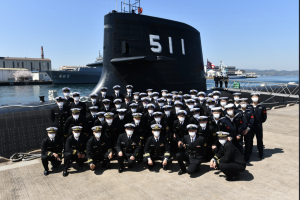The Japan Maritime Self-Defense Force’s (JMSDF) first Soryu-class diesel-electric attack submarine (SSK) fitted with lithium-ion batteries, the JS Oryu (pennant number SS 511), arrived at its new homeport in Kure, Hiroshima prefecture on April 7, the service said in a statement.
The JS Oryu will serve with the JMSDF’s Submarine Flotilla 1.
The JS Oryu was commissioned into service at the Mitsubishi Heavy Industries (MHI) facility in Kobe, in Hyogo Prefecture in west-central Japan on March 5. The boat is the 11th Soryu-class SSK commissioned into service and the sixth built by MHI. The SSK was launched in October 2018.
Lithium-ion batteries will enable the Oryu to shut off its diesel-electric propulsion and operate on battery power alone for longer periods under water. Batteries are less noisy than diesel-electric engines and reduce the SSK’s acoustic signature, making detection harder.
The JMSDF is currently the only naval service in the world to have installed this technology aboard a submarine.
In November last year, Kawasaki Heavy Industries (KHI) launched the 12th and final Soryu-class SSK, the future JS Toryu (pennant number SS 512). Like the JS Oryu, the Toryu, slated to be commissioned in March 2021, will also be fitted with lithium-ion batteries.
Soryu-class SSKs are also the first submarines of the JMSDF to be equipped with air-independent propulsion systems, as I explained elsewhere:
The (…) Soryu-class boats are the JMSDF’s first SSKs to be fitted with air-independent propulsion (AIP) systems, enabling the submarines to stay underwater for up to two weeks. (…)
Soryu-class SSKs are powered by two Kawasaki 12V 25/25 SB-type diesel engines and four Kawasaki Kockums V4-275R Stirling AIP engines for silent running. The boats have an estimated range of 6,100 nautical miles (11,297 kilometers) with a maximum surface speed of 13 knots and a subsurface travelling speed of 20 knots. The maximum diving depth of the sub is around 650 meters.
The Soryu-class is fitted with six HU-606 533 mm torpedo tubes that can accommodate Type 89 heavyweight homing torpedoes and UGM-84 Harpoon anti-ship missiles. Next to bow-and-flank-mounted Hughes/Oki ZQQ-7 sonar arrays, the sub is also equipped with a towed array sonar capable of detecting ships over 70 kilometers away.
The Oryu displaces 2,947 tonnes when surfaced and 4,100 tonnes when submerged. It has a beam of 9.1 meters and a hull draught of 8.4 meters.
The boat’s crew consists of nine officers and 56 sailors. The JMSDF on April 8 released a picture of the crew posing in front of the submarine wearing face masks to protect against infection with the new coronavirus.

































